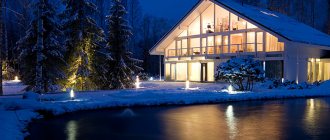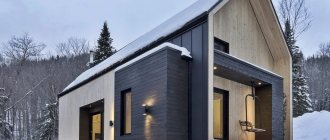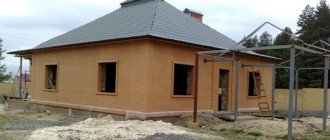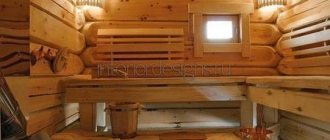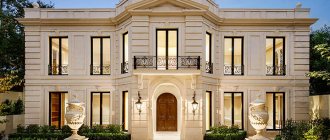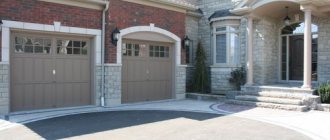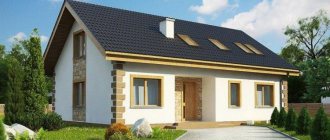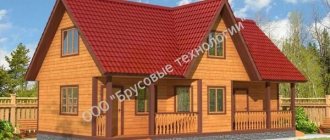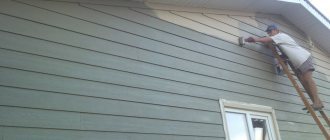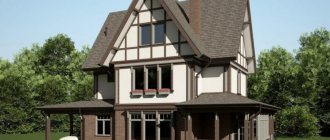In our catalog, house designs in the Russian estate style take pride of place. This is explained by the growing interest in log house construction, and logically leads to the revival of half-forgotten elements of ancient Russian architecture. Our ancestors knew how to create fabulous masterpieces from wood.
Despite the absolute external dissimilarity of each house in the catalog, they can still be divided into two large groups. One includes projects of classic Russian manor houses, the second includes ethnic stylizations such as “fairy-tale mansions”.
Russian hut in Rus'
For the construction of the most important buildings in Rus', the trunks of centuries-old trees, the length of which reached 18 meters, were used. The diameter of such a log exceeded 50 cm. At that time, there were plenty of forests with trees suitable for construction in our climatic zones. There was especially a lot of ancient forest in the north of the European part of Russia, which was called the “Northern Territory”.
The characteristics of natural wood that was used as a building material influenced the shape and design of buildings. The thickness of the log became the standard that served to measure the size of the house.
Our ancestors used resinous pine or larch wood to build walls, and lighter spruce to construct the roof. In regions where there was a shortage of coniferous forests, oak or birch served as wall material.
Not every tree could be used for construction. Only selected and prepared trunks were cut. After a certain pine tree was selected, special notches were made on its trunk, which were called “lasas”. To do this, the bark was removed in narrow strips using an ax. It was removed from top to bottom, and strips of untouched bark were left between such cuts to ensure sap flow. Such a tree should have stood for about 5 years, during which the pine actively secreted resin that impregnated the trunk. After the specified period, the tree was cut down in late autumn. If the tree stands longer, the trunk will begin to rot. Deciduous trees for the construction of a Russian hut were cut down during the spring sap flow. During this period, the bark is easily removed from the trunk, which, after drying in the sun, becomes very durable.
The main device for building a Russian hut in ancient times was an ax. Saws only appeared in the 10th century, but they were used exclusively as carpentry tools for interior work. This is because the saw teeth tear the wood fibers, opening the wood up for moisture to penetrate. When chopping with an axe, the wood fibers, on the contrary, are crushed (the ends of the logs are “sealed”). It was this technology that led to the emergence of the expression “cutting down a Russian hut.” At the same time, nails were practically not used in the construction of wooden houses, since wood rots faster around metal. If necessary, wooden crutches were used to hold the structures together.
The basis of the design of the Russian hut was the “log house” - interconnected logs folded into a quadrangle. One row of logs was called the “crown.” The lowest crown was installed on a “ryazh” - a base made of stone boulders. Such a base made the Russian hut warmer and gave the wood additional resistance to rotting.
Different types of log houses differed in the way they connected the logs to each other. During the construction of non-residential buildings, a type of log house was used, which was called “in the cut” (rarely folded logs). For such buildings, logs were laid in pairs on top of each other and sometimes they were not even fastened together. This stacking of logs was not very dense. The log house, folded “in a claw”, consisted of logs, the ends of which were carefully hewn, resembled claws and did not extend out beyond the perimeter of the wall. The crowns of such a hut fit more tightly, but in the corners of the building it could blow in the winter.
The warmest option for building a log house was called “in the oblo”. In this version of the Russian hut, the ends of the logs extended somewhat beyond the perimeter of the walls. The name of this variant of joining logs comes from the words “obolon” or “oblon”, which were used to designate the outer layer of a tree trunk (shell, envelop). At the beginning of the twentieth century, there was a term “cutting a hut into Obolon.” This is what they said if the logs inside a Russian hut were not trimmed. But still, on the outside the logs were often left round, but on the inside they were hewn to a flat state. This treatment was called “scraping into las” (lasom - smooth strip). In modern terminology, the concept of “burr” is used to designate the ends of logs protruding outwards, remaining round and with a chip.
In this case, the crowns of the log house were connected by internal spikes. Moss was laid between the rows of logs of such a log house, and after construction was completed, the cracks were caulked using flax tow. In the same way, attics were laid with the help of moss, which made it possible to retain heat in the winter.
The shape of log houses for a Russian hut could be a quadrangle (“chetverik”) or an octagon (“octagon”). The latter option was used for the construction of wooden churches. Thanks to the octagonal shape of the building, its area can be increased 6 times without changing the length of the logs. Russian huts consisted of several quadrangular log houses stacked side by side. Russian architects often stacked log houses with 4 and 8 corners on top of each other to build luxurious mansions or pyramidal temples.
A simple rectangular, covered structure made of logs was called a “cage.” The proverb “cage by cage, veg by vet” compares the reliability of such a log house in comparison with an open canopy, which was called “povet”. Quite often, the log house was installed on the “basement” - the lower auxiliary tier of the hut, which served as a storage place for household equipment and food supplies. The upper rows of the log house were folded in such a way as to expand them and obtain a kind of cornice, which was called a “fall”. This word comes from the fairly popular Old Russian verb “to fall.” In turn, “povalusha” is the upper unheated bedroom of a Russian hut, where the family slept in the summer.
Recommended reading:
- Documents for the construction of a private house in 2019
- Construction technology of a half-timbered house
- Types of foundations for a private house
To reduce heat loss in the cage, the doorways were made lower and the window openings higher. The wooden roof of the log house was also built without nails. This design was called a “male” roof. This name is due to the fact that to arrange the roof, the upper rows of walls were made of gradually decreasing stumps of logs, which were called “males”. On these logs, in the form of steps, longitudinal racks “lay down” (lay down, lie down) were laid. In some cases, “males” could refer to the endings of “slegs” that were cut into wall structures.
Thinner logs were cut into such poles (or rather, across them) from top to bottom, which were cut down along with one root branch. Since the shape of such trunks resembled a chicken’s foot, they were called “chickens,” accordingly. The branches of the roots were directed upward during laying and were used to install a hollowed out log called a “stream”; streams of rainwater from the roof were collected here. Wide roof boards were laid on top of the “chickens” so that their bottom part rested against the groove of the “streams”. Particular care had to be taken to cover the upper joints of the boards (“ridge” or “princeling”). Under such a joint there was a “ridge ledge”. From the outside, the joint of the ridge was covered with a log, which was hollowed out from the inside (“shell”, “skull” or “okhlupen” - covering the ridge).
For the roofing of the wooden roof of a Russian hut, a variety of materials were used: tufts of straw pressed with poles, planks of aspen logs (shingles), etc. Even more ancient huts could be covered with turf, with the roots turned upside down. The turf was laid on a birch bark flooring.
The most expensive option for the roof of a Russian hut was “tes” (hewn boards). To make such material, they took a smooth log without knots and split it lengthwise in several places. Wedges were driven into the resulting cracks. The log was split, then split lengthwise several more times. The resulting boards were hewn using a wide knife or an ax.
As a rule, a two-layer coating was used to construct the roof. The bottom layer, the “podder” or “podskalnik,” could be covered with birch bark (“rock”) for tightness. The final layer of the roof was called “red tes.” For the Russian hut, a kinked roof structure was also used. In this case, the flatter lower element was called the “police”. This name comes from the Old Russian word “pola” - half.
The pediment of a Russian log house was called the “brow.” As a rule, it was decorated with carvings that served as a “talisman”. The outer edges under the roof were protected with the help of long boards “prichelin”, the upper joint of which was decorated with a carved board (“towel”).
The roof was considered the most important element of a Russian hut. The saying about “a roof over your head” is often used in modern language. That is why the symbol of the Russian hut or wooden temple was the “top”.
This name was given to any element that completes the building. The “top” of a Russian hut could be different and depended on the welfare of its owners. The simplest version of such an element is an ordinary gable roof on a cage. For churches, a “tent top” was used, made in the shape of an octagonal pyramid. The “cube top” also looked original, looking like an onion with four sides. Such a design as a “barrel” was quite complex - a gable element with smooth curvilinear shapes, which was completed by a sharp ridge. Other top designs are also known - multi-domed, tiered, “crossed barrels” (two intersecting barrel-shaped structures), etc.
The ceiling was not a mandatory element of the Russian hut. One of the reasons for this is the fact that if the log house was heated “black”, then all the smoke accumulated under the ceiling. That is why ceilings were installed only when the smoke from the stove came out through a chimney. The ceiling boards were laid on massive beams, which were called “matitsa”.
The Russian hut was built as a “four-walled” (cage), or as a “five-walled” (cage, inside of which there was one wall partition “pererub”). During the construction of a Russian hut, auxiliary extensions could be added to the main structure of the log house: a “porch”, a “canopy”, a “bridge” between the hut and the yard, a “yard”, etc. In conditions of a not very mild climate, our ancestors sought to assemble the entire complex of residential and outbuildings into a single whole.
At the same time, the complex of buildings included in the courtyard could be organized in three options. “Koshel” is a Russian hut with two floors, where several people lived under one roof. In the case when auxiliary buildings were attached to the side of the house, it resembled the letter “G” and was called “verb”. Utility premises could be attached to the end of the log house in such a way that the complex was extended in one line. In this case, the building was called “beam”.
The porch leading into the house was built on the ends of long logs that came out of the wall “help” or “outlets.” Because of this feature, such a porch was called “hanging.”
After passing through the porch one could get into the “canopy”. The name of this room comes from the word “canopy,” which meant a shaded place. The canopy made it possible to keep the hut warm in winter when the external doors were opened. The front part of the Russian hut, which included the porch and canopy, is the “shoot”.
In two-story huts, there was a “upper room” on the second floor of residential buildings, and a “story” in the utility rooms. If there was another room above the second floor, then it was called a “mansion”.
Most often, access to the second floor of auxiliary buildings was possible through the “import” (an inclined platform made of logs). Even a horse harnessed to a cart with hay could climb up this design. The porch area, from which one could ascend to the second floor, was called the “locker.”
Most simple Russian huts were heated in the black way, i.e. were smoked, so the inner walls, up to about the height of a person, were white (they were specially varnished), and then - black from soot. “Voronets” (wooden shelves) were installed at the smoke border, which served as an obstacle to the descent of smoke into the lower part of the room. To vent smoke outside, small “window windows” or carved wooden pipes (“chimneys”) were installed.
In more expensive Russian huts, just like in churches, they built a gallery that surrounded the mansions on 2 or 3 sides. This design was called “gulbishche”.
Choice of colors
The palette for interior decoration also differed from the wealth of the owner. Natural colors predominated in the huts, which added warmth and comfort to the rooms. These are calm yellow shades. Brown was also a popular color. Mostly due to the fact that wooden surfaces were rarely painted at all and were left in their natural beauty.
Muted red tones were added to natural palettes. And also blue and green. These colors are also as close to natural as possible and they were used with pleasure in interior decoration.
Towers were always decorated much brighter than simple huts. The Russian style in the interior of the mansion was distinguished by richer and richer tones, which emphasized the luxury of the furnishings. This was also facilitated by large windows, which were absent in the huts.
Bright colors predominate in both drapery and curtains. And there’s no need to talk about the tablecloths.
The festive table covering has always been distinguished by a riot of colors and colorful designs. And since in the old days there was no stainless steel or chrome plating, all iron utensils were covered with bright and rich colors.
Modern house in the style of a Russian hut
Decorating a country house like a hut in a traditional Russian style is a popular and very modern solution. This style embodies the rich culture of our people and their traditions, which have been formed over centuries. A modern cottage in the style of a Russian hut can look like an original object of architectural art. In addition to aesthetic advantages, such a house is environmentally friendly, comfortable and has excellent thermal insulation characteristics.
A house in the style of a Russian hut can advantageously combine centuries-old traditions and innovative construction technologies. The classic interior of such a house should contain natural materials, the main one being wood. Traditional Russian huts, as noted earlier, were built from the trunks of coniferous trees (larch, spruce, pine). The most popular modern material for building such a house is timber.
Let's consider the features of a timber house in the style of a Russian hut:
- An abundance of carved decoration in the architectural elements of the house (carved shutters and trim on windows, porch railings, pediment decor, etc.). Planners and designers can create unique sketches of carved decoration for a wooden house.
- A spacious room filled with light is a traditional element of a Russian hut. There must be a stove in the upper room (in modern houses, the traditional stove is replaced with smaller heating equipment).
- Unheated hallway (canopy).
- Reliable gable roof with a large slope.
- The beautiful decor of the facade made of timber, which looks like a log wall, will create the impression of an old house.
- The use of natural wood as a finishing material in the interior of a modern Russian hut ensures comfortable and environmentally friendly housing.
When decorating the interiors of a modern Russian hut, the use of mahogany is not recommended. For decoration it is worth using coniferous wood, oak, ash and birch. The interior of a modern Russian hut can use elements made of limestone and natural stone.
Experts distinguish several modern trends in design in the ancient Russian style:
- “A la rus” or “Russian country” . This direction is the most popular today. The peculiarity of the “Russian country” style is the widespread use of ancient Russian symbols, as well as decor and objects made in the traditions of folk crafts.
- “Russian Izba” is a style characterized by practicality and rigor (there is no abundance of decorative elements that do not have a functional purpose).
- “Terem” is a more luxurious modern style. In this case, the architecture and interior recreate not an ordinary log house, but merchant mansions or princely chambers. This version of the “Russian hut” design has a more spectacular and even fabulous look.
- Russian classicism can also be considered a variety of the modern “Russian hut” style.
Its distinctive features are as follows:
- Architectural elements are decorated with relief and through carvings.
- The roof ridge is decorated in the style of a Russian hut.
- There is a stylish canopy above the porch.
- The window openings are decorated with carved shutters and platbands.
- Pagan symbols (birds, snakes, horses, roosters) are mainly used in decoration.
Colorful floral patterns are used to decorate cottages in a rustic style. Furniture sets for modern Russian huts are often processed using artificial aging technologies. Wide wooden benches and massive oak tables look good in such houses. In the interiors of a Russian hut, natural fabrics with colorful patterns, embroidery or lace are used.
Gorodets
According to experts, one of the best Russian carved buildings is the log house in the center of folk crafts in Gorodets.
Of course, this beautiful creation was created by the hands of modern craftsmen, but at the same time it impresses with its beauty. Each building in the crafts center is a separate workshop (for embroidery, painting, icon painting). Master classes are held within the walls of each of them for visitors. Isn't it true that the carved complex is impressive?
It’s impossible to tear yourself away from juicy fillets: bake the fish in egg whites
The head of the RDIF spoke about plans for the production of Sputnik V in Italy
Russia has begun developing a vaccine against bird flu H5N8
Exterior view of a house in the Russian Izba style
A modern house in the style of a Russian hut, the photo of which is presented above, in the classic version is built from natural wood. However, in the catalogs of construction companies there are often interesting brick options. Stone houses in the Old Russian style are one of the popular trends in modern architecture.
The most common material option for the construction of suburban housing still remains logs. A modern log house can be built using different technologies (Russian, Norwegian, Finnish, etc.).
To build a turnkey Russian hut style house, you need to take into account the main features of such buildings. For example, logs should be connected “in a cup” (another name is in a circle). In this case, the connecting elements are semicircular grooves. The logs are connected so that their ends protrude approximately 400 mm beyond the boundaries of the walls.
An alternative method of attaching logs is the option of connecting “in the paw” (without protrusions) and “in the clap” (assembly in the form of an inverted bowl, i.e., each subsequent log is laid with a notch on the previous one).
Blacksmith's house
The house of the blacksmith Kirilov is striking in its beauty. It seems that he stepped out of the pages of some fairy tale. This amazing structure is located in the village of Kunara, Sverdlovsk region. The fairytale gingerbread house was recognized as the best in Russia in 1999.
The blacksmith Sergei Kirillov created the beautiful structure with his own hands. His work lasted for thirteen long years. Construction was completed in 1967. From the appearance of the house it is clear that Sergei put his soul into it. The metal and wooden elements of the facade are simply amazing. The master's widow now lives in the fairy-tale house. The gates of her estate are open to guests who want to admire the wonderful creation of her husband’s hands.
The source of dangerous particles produced during solar flares has been discovered
In Belarus, industrial production of Sputnik V will start at the end of the month.
The 14th Dalai Lama was vaccinated against Covid-19 in his Indian city
Interior of a house in Russian hut style
There are many design options for modern interiors in the Russian hut style. This can be a practical design in the ancient Russian style or a more luxurious option, embodying the trends of a merchant house and even princely chambers. The choice of one option or another depends on the financial capabilities and preferences of the home owners. Designers can develop a design project to suit every taste.
The central element of the interior of a country two-story house in the style of a Russian hut is often a wooden staircase decorated with carved patterned columns. To give an ancient Russian flavor to a spacious living room, you can provide a large stove. Since a one-story house does not always have a sufficient amount of free space, it is not always appropriate to equip such housing with a large stove structure. As an alternative, you can install a more compact fireplace and decorate it in Russian style.
- Walls
To decorate the walls of a house in the Russian style, it is best to use natural wood. When constructing walls from timber, additional finishing is completely optional. Such walls themselves are an interesting decorative element.
If desired, paint or whitewash can be used to decorate the walls of a house in the style of a Russian hut. Often, fabrics or wallpaper with authentic patterns are used to decorate the interiors of such buildings. Interior design experts recommend not using too dark colors for wall decoration. Furniture in a “Russian hut” should be at least a tone darker than the walls.
- Furniture
The design of a house in the style of a Russian hut involves the use of massive wooden furniture (benches, cabinets, chests of drawers, tables, etc.). You can also use furniture sets upholstered in fabric. To cover such furniture, velor or other expensive fabric is often used. The legs of tables and chairs are often decorated with artistic carvings. The technique of artificial aging of furniture sets is also popular.
Pine furniture is well suited for an interior in the style of a Russian hut. This tree has an attractive color, interesting texture and is available at an affordable price. A distinctive feature of furniture in the Old Russian style is its simple design. Cabinets for the kitchen or bedroom, sets for the living room and other rooms should not include many sections, drawers and shelves.
- Lighting
A good addition to the main lighting of a house in the style of a Russian hut will be lamps in the form of lamps or candlesticks. If the interior design is based on the “mansion” or “Russian estate” trends, then for lighting the rooms you can choose lamps with lampshades and forged candlesticks.
- Decor
To decorate a house in the style of a Russian hut, designers recommend using national ethnic elements, which are presented in abundance in ordinary souvenir departments. To create a particularly colorful atmosphere, you can use wooden barrels, chests or carved boxes. But it is better to refuse plastic and modern materials when building a house in the Russian style. In this case, modern household and office equipment should also be additionally decorated.
Ceramic products and porcelain items in “Russian Izba” interiors are often decorated with folk painting, which is better known as Gzhel. It should be noted that traditionally, Gzhel is a complex hand-painted painting in blue and blue tones on a white background. Currently, such painting is not only a folk craft, which is used for painting porcelain products, but is also a fairly popular area of interior design.
To give a house built in the style of a Russian hut a fabulous flavor, you can decorate the interior with popular prints. Lubok is a popular type of graphics, characterized by simplicity of images and design.
Another popular decorative element in the Russian hut style is Khokhloma. This trend is characterized by folk ornaments on a golden background. This unique painting gives the wood the appearance of ceramics.
To emphasize the color of a modern house in the style of a Russian hut, you can buy blankets made from scraps of different colors. At the same time, on a wooden bed in the bedroom you can arrange a slide of pillows of different sizes.
Against the background of light walls in the interior of a modern “Russian hut”, furniture sets and stairs in dark colors look good. The highlight of the living room can be a designer tiled fireplace.
A modern wooden house in the style of a Russian hut, which is richly decorated with carved details, creates the impression of a real mansion from a fairy tale. This design direction is relevant not only for the design of spacious cottages. It can be successfully implemented in a small house. The design of a small home, reminiscent of a village hut, will be well complemented by a warm, artificially aged rug located in the middle of the room.
Pros and cons of buildings
One of the main advantages of the Russian style is the use of natural materials in construction. Wood and stone combine perfectly with each other and allow you to create a cozy home with an original design.
Also, such buildings allow you to pay tribute to your ancestors. A timber base and a properly designed interior will help turn the house into a kind of museum, which will contain objects reminiscent of ancient times.
House made of timber Source stroy-podskazka.ru
Interiors in the ancient Russian style are incredibly beautiful and attractive. You can use a huge number of different decorative elements that will help decorate the room.
The only downside is the high price of materials for construction. Also, not everyone will like the Russian style, so it is better to familiarize yourself with the options for this design in advance.
